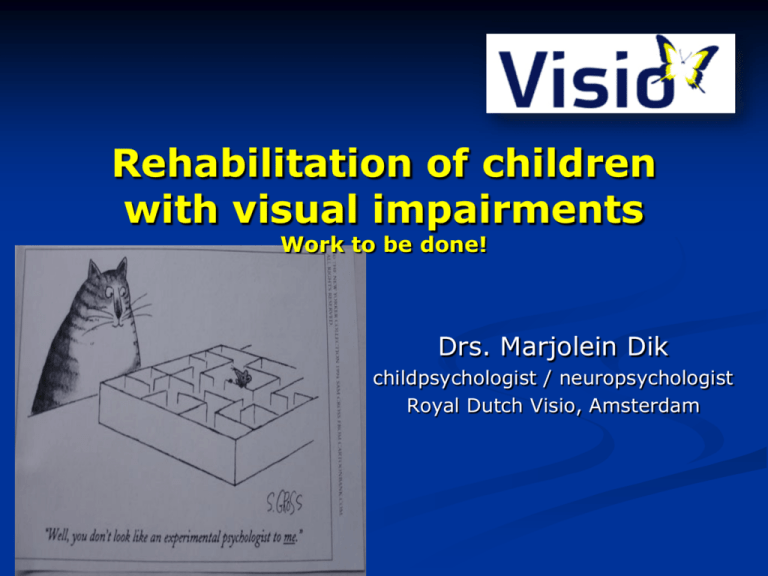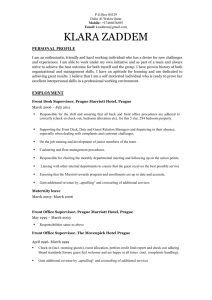
Rehabilitation of children
with visual impairments
Work to be done!
Drs. Marjolein Dik
childpsychologist / neuropsychologist
Royal Dutch Visio, Amsterdam
Work to be done!
1.
2.
3.
4.
5.
6.
7.
Lebers Congenital Amaurosis
Developmental setback and autism
Coloboma
CVI
Prematurely born children
Visual-motor system/Attention
?
Prague & Brussels 2015
Lebers Congenital Amaurosis
Early onset of TRD
So far more than 18 genes have been
found
Developmentally very interesting group
Urgent! Gene / gene combination for
phenotype subgroups in order two inform
parents from the start on what is ahead of
them.
Prague & Brussels 2015
Features
Early visual reactions to
movement/patterns –
disappearing/some colour
Some high hyperopia – no
effect of glasses
Eye poking, deep eye
pockets
Facial comparable?
Forehead
Hypermobility; low muscle
tone
Over/under registration
problems (SI)
Cognitive fit
Social emotional less fast
Breaking point 15-18
months
Split in 2 main
developmental groups
Parents
Musically gifted
Prague & Brussels 2015
Features
Early visual reactions to
movement/patterns –
disappearing/some colour
Some high hyperopia – no effect
of glasses
Eye poking, deep eye pockets
Facial comparable? Forehead
Hypermobility; low muscle tone
Over/under registration problems
(SI)
Cognitive fit
Social emotional less fast
Breaking point 15-18 months
Split in 2 main developmental
pheno groups
Parents
Musically gifted
Prague & Brussels 2015
Developmental setback, TOM, Autism
1/3 of children with autism shows developmental setback –
much more in blind children
In normal population: incidence ASD 0,6-1%
About twice as often in blind children
Autism as a consequence of blindness itself?
No!
Neural programming – Parietal development?
Cilio pathy or other cell metabolism programming?
Hobson, R. P., & Bishop, M. (2003). The pathogenesis of autism: Insights from congenital blindness. Philosophical
Transactions of the Royal Society of London: Series B: Biological Sciences, 358, 335– 344.
Hobson, R. P., Lee, A., & Brown, R. (1999). Autism and congenital blindness. Journal of Autism and Developmental
Disorders, 29, 45–56.
Prague & Brussels 2015
Sugiyama S, Di Nardo AA, Aizawa S, Matsuo I, Volovitch M, Prochiantz A, Hensch TK. (2008)
Experience- dependent transfer of Otx2 homeoprotein into the visual cortex activates postnatal
plasticity. Cell 134:508-520.
Morishita H, Hensch TK. (2008) Critical period revisited: impact on vision. Curr Opin Neurobiol.
18: 101-107.
Waugh, M.C., Chong, W.K., Sonksen, P.M. (1998) Neuroimaging in children with congenital
disorders of the peripheral visual system . Developmental Medicine and Child neurology, 40, 812 –
819
Sonksen,P.M., Dale, N. (2002). Visual impairment in infancy: impact on neurodevelopmental and
neurobiological processes. Developmental Medicine & Child Neurology 2002, 44: 782–791
Begeer, S.; Dik, M,; voor de Wind, M.J.; Asbrock, D.; Brambring, M.; Kef, S. (2014). A New Look
at Theory of Mind in Children With Ocular and Ocular-Plus Congenital Blindness. Journal of Visual
Impairment & Blindness. Jan/Feb2014, Vol. 108 Issue 1, p17-27. 11p. 1 Chart. (9-22 children)
Developmental setback in children with congenital blindness, Literature review and record analysis
Ans van Eijden, Ellen van den Broek Royal Dutch Visio, The Netherlands
(work in progress)
Prague & Brussels 2015
To be done
Search together!
Collect all gene information at one /two points
Who/where?? London?
Ask the grown ups LCA to participate (11 of 45)
Prospective research- describe development the
same way, measure at the same time and with
the same instruments in order to offer the right
intervention
Parents need to know what is ahead of them!
Prague & Brussels 2015
coloboma
Relatively stable but …..
.child diagnosis iris
retina
macula
F 98
Micropth
complex
x
x
x
F 97
idem
x
x
x
F 98
micropth
papil
x
x
Visus
early
0,06
later
later
0,12
0,16
0,8/ 1.-
0,75/0,25
0,12/0,3
0,25
0,12
0,05
No neurological problems
ERG normal, 1 VEP indicated a bit higher acuity
Suspect for aggravation, psychogenic loss?
No! Professional feels helpless. Is this something
specific? Do you recognise it?
Who wants to collect?
Prague & Brussels 2015
Cerebral visual
impairment
CVI
Prague & Brussels 2015
ICF functional discrepancy model: 5 steps to get to CVI
1.Ophthalmologist/optometrist
diagnoses
b210 Seeing functions Sensory functions
visual acuity functions; visual field functions;
quality of vision; functions of sensing light
and colour, visual acuity of distant and near
vision, monocular and binocular vision; etc.
b215 Functions of structures adjoining
the eye (movement aspect)
Team: Can activity and participation
problems be explained by developmental
level and these data?
2.
Yes: standard approach for sensory impairments
No:
Neuropsychologist chooses testmaterial taking into
account all available diagnoses - also
brainstruccture information (s110) from
neurologist - to formulate hypotheses
3. Find information about, measure and compare the following functions:
b110 consciousness/b130 energy and
drive functions
b117 (verbal) Intellectual functions
b122 Global psychosocial functions
b7.. Movement related functions
b144 non visual memory functions
b140 non visual attentional functions
B164 executive (higher cognitive)
functions
4.
5.
=
b1561 visual perception
b1565 visuo-spatial perception
B144
visual memory
b140
visual attention
b760
visual-motor integration
Team: Validate each visual problem: mild, moderate, severe, complete impairment
Team: Help is indicated by one complete/ severe, ? moderate and ? mild
(taking other diagnoses into account as well)
Prague & Brussels 2015
Issues
Features ↔Functions
Questionnaires ↔Tests with age norms
Excluding executive functioning ! (“just” posterior
attention= selective and directing/orienting)
Changes over time/development/age
Co-morbidity; along with other health problems
Prague & Brussels 2015
How about age and co-morbidity ?
age
diagnosis
acuity
Fld
SIP
☺
M0
VIQ
☺
ear
☻
Lat
Rec
ear
DTVP2
FC FB
Vis
Mry
Spa
Ori
Speed
up
Attent
SOP
Ps
So
Pho
LM
♂95
ROP/PVLI(lFr)
0,25 →0,7
☼
-
+
93/80
+
+
+
10
+
±RF7
++
- + +
+
-
♂98
ROP+
hydroc
0,08
☼
++
+
98
-
-
-
6 11
VPOR
11of 30
++
±
++
+ + -
-
+
♀98
↓ braintss ci
<0,1 → 0.6
±
- -
±
110
-
+
-
8
8
8
±
±
-++
+
+
♂99
asphyxia
0,6A 0,4 L
☼
-
+
82
+
+
+
9
7
9
+
+
- - +
±
-
♂00
Hydroc 3x
0,1
☼
-
-
92
+
+
-
+(7) 7
+
±
-
- + +
+
+
♂01
car arr/PrOc/CP
0.25
↓HF
- -
-
79
-
+
-
7
9, 8
±RF6
-
- + ±
±
-dp
♂01
ROP/prem
0,6A/0,4L/0,2N
R↓
-+
+
101
+
+
+
11 13
++
+
+
- - +
+
-
♂02
ROP prem
(at 4)
0,1 →
0.5A 0.25L
+
-
±
103
?
+
?
10 11
+
+
-
- - -
-
+
♂03
Catar/metabl
0,2L/0,25A
+
- -
±
88
-
+
-
11 11
+
+
±
- + +
+
-dp
♀05
Heamorr
hypoglycem
0,25/0,2
L+
-
-
91
-
+
-
10 10
+
+
-
- - -
+
-dp
Prague & Brussels 2015
7
8
In our rehabilitation practice (a selected group)
About 40% of the children keeps the diagnosis CVI getting older
(hydrocephalus!)
About 60% of the children (in our region!) shows more severe
other functional problems (dyspraxia, dyslexia, severe
coordination problems, ADHD) over time.
Early visual problems as a warning/marker of more to come
CVI in young children has to be followed into school age – about
50% (in our region!) shifts to another kind of help service.
Naming?
New challenge: Multi domain disabilities with relatively intact
intelligence (complex learning disabilities ≠CVI )!
Prague & Brussels 2015
Pre mature
birth
and visual
impairment
age
diagnosis
acuity
Fld
SIP
☺
M
0
VIQ
☺
ea
r
☻
La
t
Re
c
ear
DTVP
2
FC FB
Vis
Mr
y
Spa
Ori
Spee
d
up
Atten
t
SOP
Ps
S
o
Ph
o
LM
♂95
ROP/PVL I
(lFr)
0,25 →0,7
☼
-
+
93/80
+
+
+
10
+
±RF
7
++
- + +
+
-
♂01
ROP/prem
0,6A/0,4L/0,2N
R↓
-+
+
101
+
+
+
11 13
++
+
+
- - +
+
-
♂02
ROP prem
(at 4)
0,1 →
0.5A 0.25L
+
-
±
103
?
+
?
10 11
+
+
-
- - -
-
+
Prague & Brussels 2015
7
High Incidence of Multi-Domain Disabilities in Very Preterm Children at Five Years of Age
Eva S. Potharst, MsC, Aleid G. van Wassenaer, MD, PhD, Bregje A. Houtzager, PhD, Janeline W. P. van Hus, BHS,
Bob F. Last, PhD, and Joke H. Kok, MD, PhD
Objectives To describe the prevalence and co-occurrence of disabilities and their association with parental education
in preterm children and term control subjects.
Study design In a prospective study, preterm children (n = 104), born at <30 weeks’ gestation or birth weight
<1000 g, and term children (n = 95) were assessed at corrected age 5 with an intelligence quotient (IQ) test,
behavior questionnaires for parents and teachers, and motor and neurologic tests. A disability was defined
as results in the mild abnormal range of each test or below. Associations of outcomes with parental education
were studied.
Results Of the preterm children, 75% had at least one disability and 50% more than one, compared with
27% and 8%, respectively, of term control subjects (P < .01). The preterm-term difference in full scale IQ
increased from 5 IQ points if parental education was high to 14 IQ points if it was low, favoring the term
children in both groups. A similar pattern was found for behavior, but not for motor and neurologic outcome.
Conclusions Disabilities occur frequently after very preterm birth and tend to aggregate. Neurologic and
motor outcomes are mostly influenced by biologic risk, and social risks contribute to cognitive and behavioral
outcome. (J Pediatr 2011;159:79-85).
Prague & Brussels 2015
A functional approach to cerebral visual impairments in very preterm/very-low-birth-weight children
Christiaan J.A. Geldof1,2, Aleid G. van Wassenaer-Leemhuis3, Marjolein Dik2, Joke H. Kok3 and Jaap
Oosterlaan1,4
Received 8 September 2014; accepted 19 January 2015; advance online publication 00 Month 2015.
doi:10.1038/pr.2015.83 Copyright © 2015 International Pediatric Research Foundation, Inc.
Vaker visueel sensorische én
perceptieve stoornissen
Vaker stoornissen in visueel
zoeken en aandacht
CVI lijkt een indicator voor
ontwikkelingsproblemen van
ernstig vroeggeboren kinderen
te zijn
Prague & Brussels 2015
8 year old boy (born at 27 wks)
Mean intelligence
Oversensitive for light, haptic underregistration,
cann’t sit still
Gets too close to work for acuity 0,62 ODS,
0,4Lin 0,5 Ang, fixation problems (glasses -4)
Attention: finds enough targets, needs more time
and fingers (normscore 7), “neglect” left sided
underneath
Visual Perception; mean scores
VMI: Beery mean scores (on paper); action fails
on right side (bumps into things at that side) also
his balance is less developed
Prague & Brussels 2015
Prague & Brussels 2015
Sub test Space ships Tea-Ch
NEPSYI
Prague & Brussels 2015
Prague & Brussels 2015
Ataxia & eye movements
Prague & Brussels 2015
Visual- motor integration
Eye-hand and eye
–foot coordination
Usually tested with
Beery or DTVP2 –
on paper while
sitting still
How and what do
we test in action
with the whole
body?
Prague & Brussels 2015
In action !
Front. Hum. Neurosci., 02 July 2013 | http://dx.doi.org/10.3389/fnhum.2013.00324
Guidelines and quality measures for the diagnosis of optic ataxia
Svenja Borchers1, Laura Müller2, Matthis Synofzik3,4 and Marc Himmelbach1,5*
1Division of Neuropsychology, Department of Cognitive Neurology, Centre for Neurology, Hertie-Institute for Clinical Brain
Research, Eberhard Karls University, Tübingen, Germany.2Department of Psychiatry, Psychosomatics and Psychotherapy,
University of Würzburg, Würzburg, Germany. 3Department of Neurodegenerative Diseases, Hertie-Institute for Clinical Brain
Research, Eberhard Karls University, Tübingen, Germany
4German Research Center for Neurodegenerative Diseases (DZNE), Eberhard Karls University, Tübingen, Germany
5Centre for Integrative Neuroscience, Eberhard Karls University, Tübingen, Germany
Optic ataxia: misreaching for
peripheral targets where as actions
in central vision are spared
Rizzo & Vecera 2002
Anatomic base : Parietal occipital
sulcus+junction (Prado 2005)
Christopher Striemer (2007) Overall
decrease in the salience (orienting
attention, disengaging) of stimuli in
the ataxic field
Stephen Jackson (2007) an inability
to construct and utilise intrinsic
(limb based) motor codes when
visual cues are available
White matter damage also unilateral
lesions
Independent visual space
perception, differences for left Prague
& Brussels 2015
right
Action VMI & attention
British Journal of Visual Impairment 2015, Vol. 33(1) 66– 73
© The Author(s) 2014
Reprints and permissions:
sagepub.co.uk/journalsPermissions.nav
DOI: 10.1177/0264619614553860
jvi.sagepub.com
BJVI
Some children with multiple disabilities and cerebral visual
impairment can engage when enclosed by a ‘tent’: Is this
due to Balint syndrome?
Suzanne Little
Meldreth Manor School, UK
Gordon N Dutton
Glasgow Caledonian University, UK
Abstract
This article describes and reflects upon the use of diffusely coloured
tents to enclose both child and therapist which, in our service, has
brought about remarkable transformations in attention, engagement,
and understanding for severely impaired children with multiple
disabilities and cerebral visual impairment (MDVI). A brief overview
of how to construct this simple tent is presented, and the ways in
which these tents have proved effective are described by means of
two case studies of students with complex needs. The positive
impact over a 2-year period was considerable. The changes brought
about persisted into typical environments, and parents and carers
expressed surprise and delight at the outcome. The proposed
explanation is that the children who benefitted had profound
impairment in seeing more than one or two items at once
(simultanagnosia) due to presumed damage in the posterior parietal
lobes of the brain, related to their cerebral palsy, and that elimination
of distraction allowed this limited visual function to be recruited, to
afford meaningful experience and enhance learning.
Prague & Brussels 2015
Neuropsychologia 44 (2006) 2734–2748 No double-dissociation between optic ataxia and visual agnosia:
Multiple sub-streams for multiple visuo-manual integrations
L. Pisella a,b, F. Binkofski c, K. Lasek c, I. Tonid,e, Y. Rossetti a,b,∗
a INSERM UMR-S 534, Institut National de la Sant´e et de la Recherche M´edicale, and Universit´e Claude Bernard-Lyon,
Espace et Action, Bron, France
b ‘Mouvement et Handicap’, ‘Institut F´ed´eratif des Neurosciences de Lyon’ and ‘Hospices Civils de Lyon’, France
c Department of Neurology and NeuroImage Nord, University Hospital Schleswig-Holstein, Campus Luebeck, Germany
d F.C. Donders Centre for Cognitive Neuroimaging, Radboud University Nijmegen, The Netherlands
e Njimegen Institute for Cognition and Information, Radboud University Nijmegen, The Netherlands
Received 27 July 2005; received in revised form 10 March 2006; accepted 17 March 2006 Available online 6 June 2006
Abstract
The current dominant view of the visual system is marked by the functional and anatomical dissociation between a ventral
stream specialized for perception and a dorsal stream specialised for action. The “double-dissociation” between visual agnosia
(VA), a deficit of visual recognition, and optic ataxia (OA), a deficit of visuo-manual guidance, considered as consecutive to
ventral and dorsal damage, respectively, has provided the main argument for this dichotomic view. In the first part of this
paper, we show that the currently available empirical data do not suffice to support a double-dissociation between OA and
VA. In the second part, we review evidence coming from human neuropsychology and monkey data, which cast further
doubts on the validity of a simple double-dissociation between perception and action because they argue for a far more
complex organisation with multiple parallel visual-to-motor connections:
1. A dorso-dorsal pathway (involving the most dorsal part of the parietal and pre-motor cortices): for immediate visuo-motor
control—with OA as typical disturbance. The latest research about OA is reviewed, showing how these patients exhibit deficits
restricted to the most direct and fast visuo-motor transformations. We also propose that mild mirror ataxia, consisting of
misreaching errors when the controlesional hand is guided to a visual goal though a mirror, could correspond to OA with an
isolated “hand effect”.
2. A ventral stream-prefrontal pathway (connections from the ventral visual stream to pre-frontal areas, by-passing the
parietal areas): for “mediate” control (involving spatial or temporal transpositions [Rossetti, Y., & Pisella, L. (2003). Mediate
responses as direct evidence for intention: Neuropsychology of Not to-, Not now- and Not there-tasks. In S. Johnson (Ed.),
Cognitive Neuroscience perspectives on the problem of intentional action (pp. 67–105). MIT Press.])—with VA as typical
disturbance. Preserved visuo-manual guidance in patients with VA is
restricted to immediate goal-directed guidance, they exhibit deficits for delayed or pantomimed actions.
3. A ventro-dorsal pathway (involving the more ventral part of the parietal lobe and the pre-motor and pre-frontal areas): for
complex planning and programming relying on high representational levels with a more bilateral organisation or an
hemispheric lateralisation—with mirror apraxia, limb apraxia and spatial neglect as representatives. Mirror apraxia is a deficit
that affects both hands after unilateral inferior parietal lesion with the patients reaching systematically and repeatedly toward
the virtual image in the mirror. Limb apraxia is localized on a more advanced conceptual level of object-related actions and
results from deficient integrative, computational and “working memory” capacities of the left inferior parietal
lobule.Acomponent of spatialworking memory has recently been revealed also in spatial neglect consecutive to lesion
involving the network of the right inferior parietal lobule and the right frontal areas. We conclude by pointing to the
differential temporal constraints and integrative capabilities of these parallel visuo-motor pathways as keys to interpret the
Prague & Brussels 2015
neuropsychological deficits.
© 2006 Elsevier Ltd. All rights reserved
Action VMI & attention
Most severe health problems: dead tired, no joy
in playing/sporting with age mates, hating new
situations
Especially in children with ataxia..
Some miss all functional integration – so
auditory/motor, haptic/motor, visual/auditory
Who is testing this? Nobody!
How?
How name it and describe it?
No norms for children available
Symposium in June 2016 to prepare a joint
protocol for this domain with motor rehabilitation
Prague & Brussels 2015
1697
First description of genetic
prosopagnosia in Europe
Thank you for
divided attention
with Amsterdam!
marjoleindik@visio.org
info@marjoleindik.com
www.marjoleindik.com
Prague & Brussels 2015





